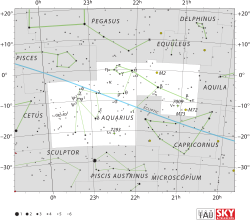Bunda
| Bunda (ξ) | |
 | |
| Observationsdata Epok: J2000.0 | |
|---|---|
| Stjärnbild | Vattumannen |
| Rektascension | 21t 37m 45,10931s[1] |
| Deklination | -07° 51′ 15,1299″[1] |
| Skenbar magnitud () | +4,682[2] |
| Stjärntyp | |
| Spektraltyp | A7 V[3] |
| U–B | +0,187[2] |
| B–V | +0,181[2] |
| Astrometri | |
| Radialhastighet () | -26,2[4] km/s |
| Egenrörelse (µ) | RA: +114,20[1] mas/år Dek.: -25,03[1] mas/år |
| Parallax () | 18,26 ± 0,24[1] |
| Avstånd | 179 ± 2 lå (54,8 ± 0,7 pc) |
| Absolut magnitud () | +1,9[5] |
| Detaljer | |
| Massa | 1,9[5] M☉ |
| Radie | 3[6] R☉ |
| Luminositet | 34[6] L☉ |
| Temperatur | 7 691[7] K |
| Metallicitet | -0,03[7] dex |
| Vinkelhastighet | 170[8] km/s |
| Andra beteckningar | |
| Bunda, ξ Aqr, 23 Aquarii, BD-08 5701, FK5 1569, HD 205767, HIP 106786, HR 8264, SAO 145537. [9] | |
Bunda[10] eller Xi Aquarii (ξ Aquarii, förkortat Xi Aqr, ξ Aqr) som är stjärnans Bayerbeteckning, är en dubbelstjärna belägen i den mellersta delen av stjärnbilden Vattumannen. Den har en skenbar magnitud på 4,68[2] och är synlig för blotta ögat där ljusföroreningar ej förekommer. Baserat på parallaxmätning inom Hipparcosuppdraget på ca 18,3[1] mas, beräknas den befinna sig på ett avstånd på ca 179 ljusår (ca 55 parsek) från solen.
Nomenklatur
[redigera | redigera wikitext]Tillsammans med Beta Aquarii (Sadalsuud) utgjorde Xi Aquarii den persiska mångården Bunda.[11] I stjärnkatalogen i Al Achsasi al Mouakket-kalendern, betecknades stjärnan som Thanih Saad al Saaoud, som översatts till latin som Secunda Fortunæ Fortunarum, vilket betyder "Den andra lyckans lycka".[12] Denna stjärna, tillsammans med Beta Aquarii och 46 Capricorni, var Sa'd al Su'ud(سعد السعود), "Lyckornas lycka".[11][13]
År 2016 organiserade Internationella astronomiska unionen en arbetsgrupp för stjärnnamn (WGSN)[14] med uppgift att katalogisera och standardisera riktiga namn för stjärnor. WGSN bestämde sig för att ange riktiga namn till enskilda stjärnor i stället för hela konstellationer[15] och fastställde namnet Bunda för Xi Aquarii A i juni 2018 och detta är nu inskrivet i IAU:s Catalog of Star Names.[10]
Egenskaper
[redigera | redigera wikitext]Primärstjärnan Xi Aquarii A är en blå till vit stjärna i huvudserien av spektralklass A7 V[3]. Den har en massa som är ca 1,9[5] gånger större än solens massa, en radie som är ca 3[6] gånger större än solens och utsänder från dess fotosfär ca 34[6] gånger mera energi än solen vid en effektiv temperatur av ca 7 700[7] K.
Xi Aquarii är en enkelsidig dubbelstjärna, vilket innebär att närvaron av en osynlig följeslagare kan härledas från Dopplerskiftningar i spektrets absorptionslinjer. De två himlakropparna kretsar kring varandra med en omloppsperiod av 8 016 dygn (22 år) med en excentricitet av 0,54.[16] Orbitaldata visar att följeslagaren, Xi Aquarii B, antingen är en röd dvärg eller en vit dvärgstjärna.[5]
Referenser
[redigera | redigera wikitext]- Den här artikeln är helt eller delvis baserad på material från engelskspråkiga Wikipedia, tidigare version.
Noter
[redigera | redigera wikitext]- ^ [a b c d e f] van Leeuwen, F. (2007), "Validation of the new Hipparcos reduction", Astronomy and Astrophysics, 474 (2): 653–664, arXiv:0708.1752, Bibcode:2007A&A...474..653V, doi:10.1051/0004-6361:20078357.
- ^ [a b c d] Gutierrez-Moreno, Adelina; et al. (1966), "A System of photometric standards", Publ. Dept. Astron. Univ. Chile, Publicaciones Universidad de Chile, Department de Astronomy, 1: 1–17, Bibcode:1966PDAUC...1....1G.
- ^ [a b] Levato, H. (January 1975), "Rotational velocities and spectral types for a sample of binary systems", Astronomy and Astrophysics Supplement Series, 19: 91–99, Bibcode:1975A&AS...19...91L.
- ^ Abt, H. A.; Levy, S. G. (March 1974), "Reinvestigation of certain long-period A-type binaries", Astrophysical Journal, 188: 291–294, Bibcode:1974ApJ...188..291A, doi:10.1086/152716.
- ^ [a b c d] Goncharov, G. A.; Kiyaeva, O. V. (April 2002), "Astrometric Orbits from a Direct Combination of Ground-Based Catalogs with the Hipparcos Catalog", Astronomy Letters, 28 (4): 261–271, Bibcode:2002AstL...28..261G, doi:10.1134/1.1467262
- ^ [a b c d] https://www.universeguide.com/star/xiaquarii. Hämtad 2018-11-07.
- ^ [a b c] Soubiran, C.; Le Campion, J.-F.; Cayrel de Strobel, G.; Caillo, A. (June 2010), "The PASTEL catalogue of stellar parameters", Astronomy and Astrophysics, 515: A111, arXiv:1004.1069, Bibcode:2010A&A...515A.111S, doi:10.1051/0004-6361/201014247.
- ^ Royer, F.; Zorec, J.; Gómez, A. E. (February 2007), "Rotational velocities of A-type stars. III. Velocity distributions", Astronomy and Astrophysics, 463 (2): 671–682, arXiv:astro-ph/0610785, Bibcode:2007A&A...463..671R, doi:10.1051/0004-6361:20065224.
- ^ "ksi Aqr". SIMBAD. Centre de données astronomiques de Strasbourg. Hämtad 2012-07-02.
- ^ [a b] "Naming Stars". IAU.org. Hämtad 18 juni 2018.
- ^ [a b] Allen, R. H. (1963), Star Names: Their Lore and Meaning (Reprint ed.), New York: Dover Publications Inc, p. 52, ISBN 0-486-21079-0, hämtad 2010-12-12.
- ^ Knobel, E. B. (June 1895), "Al Achsasi Al Mouakket, on a catalogue of stars in the Calendarium of Mohammad Al Achsasi Al Mouakket", Monthly Notices of the Royal Astronomical Society, 55 (8): 429, Bibcode:1895MNRAS..55..429K, doi:10.1093/mnras/55.8.429.
- ^ β Aqr as Nir Saad al Saaoud or Lucida Fortunæ Fortunarum (the brightest of luck of lucks) and ξ Aqr as Thanih Saad al Saaoud or Secunda Fortunæ Fortunarum (the second of luck of lucks). c Cap should be Thalath Fortunæ Fortunarum or Tertia Fortunæ Fortunarum (the third of luck of lucks) consistently, but Al Achsasi Al Mouakket was not designated the title for this star with uncleared consideration. Possibly according to the differences of opinion with R. H. Allen.
- ^ "IAU Working Group on Star Names (WGSN)". Retrieved 22 May 2016.
- ^ "WG Triennial Report (2015-2018) - Star Names" (PDF). p. 5. Hämtad 2018-07-14.
- ^ Abt, Helmut A. (August 2005), "Observed Orbital Eccentricities", The Astrophysical Journal, 629 (1): 507–511, Bibcode:2005ApJ...629..507A, doi:10.1086/431207
